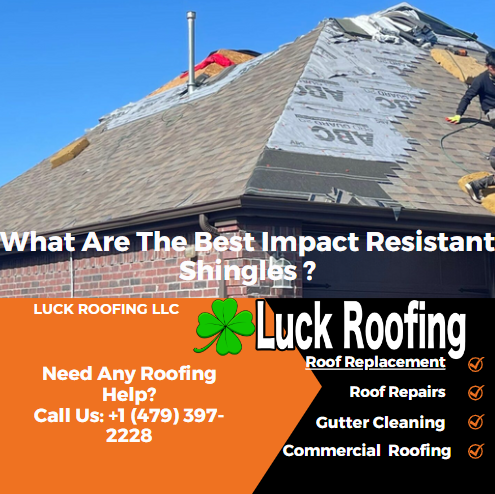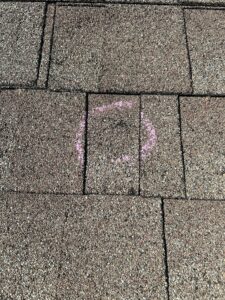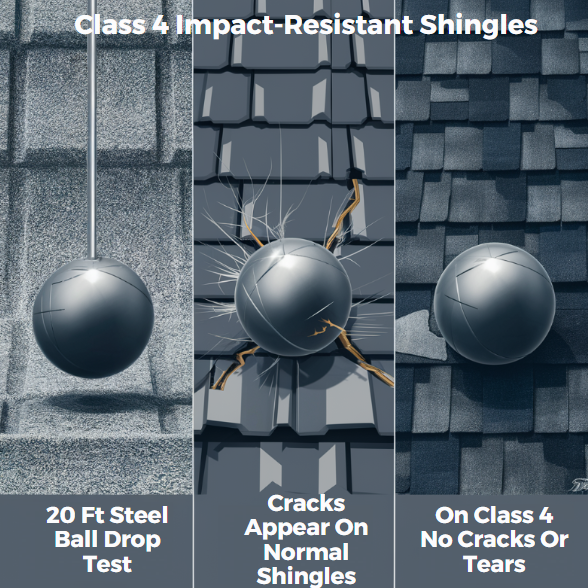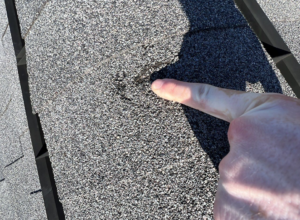
What Are The Best Impact Resistant Shingles ?
When it comes to safeguarding your home against the unpredictable forces of nature, choosing the right shingles can make a significant difference in protecting your investment. The discussion surrounding the best impact-resistant shingles explores the technical specifications, durability, and performance metrics that set them apart from traditional roofing materials. Understanding what makes these shingles resilient to extreme weather conditions can provide homeowners with valuable insights into making informed decisions when it comes to securing their homes. Stay tuned to uncover the key factors that make Class 4 shingles the top choice for impact resistance in the roofing industry.
Key Points In This Article
- Class 4 shingles offer the highest impact rating for superior protection against hail and high winds.
- They are rigorously tested under UL 2218 Class and integrate durable materials like polymer-modified asphalt.
- Class 4 shingles can withstand hailstones up to 2 inches in diameter, reducing the likelihood of costly repairs.
- These shingles provide UV protection, flexibility, and resistance to cracking, ensuring long-term durability.
- Choosing Class 4 shingles can lead to lower insurance premiums, making them a cost-effective option for areas prone to severe weather.
Luck Roofing stands as Fort Smith’s best roofing company for both commercial and residential roofing requirements, delivering a full spectrum of services encompassing roof repairs, installation, maintenance, and replacement across flat, metal or shingle roofs. Our proficient team is committed to preserving your home’s structural integrity, adeptly remedying leaks, and boosting energy efficiency. Prioritizing safety, optimal drainage, and ventilation, we furnish dependable roofing solutions customized for homeowners, all underpinned by robust warranties to instill peace of mind. Learn more about 3-Tab Shingles Vs. Architectural Shingles
Impact Resistance Importance
 The importance of impact resistance in shingles cannot be overstated when safeguarding homes against severe weather conditions such as hailstorms and high winds. Hail, in particular, poses a significant threat to roofs, as the impact of hailstones can cause extensive damage if the roofing material is not sufficiently resilient. This is where impact-resistant shingles, such as Class 4 roofing shingles, play a crucial role in protecting homes.
The importance of impact resistance in shingles cannot be overstated when safeguarding homes against severe weather conditions such as hailstorms and high winds. Hail, in particular, poses a significant threat to roofs, as the impact of hailstones can cause extensive damage if the roofing material is not sufficiently resilient. This is where impact-resistant shingles, such as Class 4 roofing shingles, play a crucial role in protecting homes.
Class 4 roofing shingles are specifically designed to withstand the impact of debris at high speeds, making them highly durable and reliable in extreme weather conditions. These shingles undergo rigorous testing procedures, including simulations of hailstone impacts at speeds of up to 90 mph, to ensure their ability to withstand such forces. This level of testing guarantees that Class 4 shingles provide an extra layer of defense against damage, reducing the likelihood of costly repairs or replacements due to hail or other impacts.
Class 4 Shingles Explanation
 When considering the resilience of roofing materials against severe weather conditions like hailstorms and high winds, Class 4 Impact-Resistant Shingles emerge as an exceptional choice due to their superior impact rating. These shingles have the highest impact rating among roofing materials, making them highly durable and capable of withstanding harsh weather elements.
When considering the resilience of roofing materials against severe weather conditions like hailstorms and high winds, Class 4 Impact-Resistant Shingles emerge as an exceptional choice due to their superior impact rating. These shingles have the highest impact rating among roofing materials, making them highly durable and capable of withstanding harsh weather elements.
In order to achieve a Class 4 rating, these shingles undergo rigorous testing, such as the steel ball test where steel or ice balls of 2 inches are dropped from a height of 20 feet onto the shingles. This testing ensures that Class 4 shingles can withstand hailstones up to 2 inches in diameter, providing a high level of protection for homes against hail damage on shingle roofs.
Class 4 shingles are certified under UL 2218 CLASS, which signifies their exceptional strength and durability. It is important to note that while Class 4 shingles offer superior impact resistance when new, their resilience may decrease over time as they age.
Therefore, regular maintenance and inspection are crucial to ensure that these shingles continue to provide optimal protection for the roof. By choosing Class 4 Impact-Resistant Shingles, homeowners can have peace of mind knowing that their roofs are well-equipped to handle the challenges posed by severe weather conditions.
Shingle Manufacturing Process
 Utilizing a meticulous process that integrates polymer-modified asphalt for enhanced durability, the manufacturing of impact-resistant shingles involves several key steps to ensure their resilience against harsh environmental conditions. The manufacturing process begins with the selection of base materials, which typically include a fiberglass mat or organic felt. These materials provide a strong foundation for the shingles.
Utilizing a meticulous process that integrates polymer-modified asphalt for enhanced durability, the manufacturing of impact-resistant shingles involves several key steps to ensure their resilience against harsh environmental conditions. The manufacturing process begins with the selection of base materials, which typically include a fiberglass mat or organic felt. These materials provide a strong foundation for the shingles.
Once the base materials are chosen, they are coated with asphalt, which serves as a waterproofing agent and adds an additional layer of protection. The asphalt coating plays a crucial role in enhancing the shingles’ durability and longevity. Additionally, the granule surface on the shingles not only adds aesthetic appeal but also provides UV protection and increases impact resistance.
Moreover, elastomeric materials are incorporated into the shingle manufacturing process to enhance flexibility and prevent cracking. This elastomeric material ensures that the shingles can withstand bending and flexing without sustaining damage, making them ideal for areas prone to extreme weather conditions. By combining these elements in the manufacturing process, impact-resistant shingles are able to offer superior protection against environmental factors, ensuring long-lasting performance and durability for homeowners.
UL 2218 Class 4 Testing
 An essential evaluation method for assessing the impact resistance of roofing materials is the UL 2218 Class 4 Testing, which involves dropping a 2-inch steel ball from a height of 20 feet. This test is crucial for determining the durability of shingles against impact. During the UL 2218 Class 4 Testing, shingles are subjected to two impacts in the same spot. After the test, damage assessment includes checking for tears, indentations, and crushed granules. Visible tears or cracks on the shingles post-testing indicate shingle failure in the UL 2218 Class 4 Testing.
An essential evaluation method for assessing the impact resistance of roofing materials is the UL 2218 Class 4 Testing, which involves dropping a 2-inch steel ball from a height of 20 feet. This test is crucial for determining the durability of shingles against impact. During the UL 2218 Class 4 Testing, shingles are subjected to two impacts in the same spot. After the test, damage assessment includes checking for tears, indentations, and crushed granules. Visible tears or cracks on the shingles post-testing indicate shingle failure in the UL 2218 Class 4 Testing.
The UL 2218 Class 4 Testing serves as a reliable method for manufacturers and consumers to gauge the ability of shingles to withstand impact from hail, debris, or other sources. By undergoing this rigorous testing process, shingle manufacturers can ensure that their products meet the necessary standards for impact resistance. Consumers, on the other hand, can utilize the results of the UL 2218 Class 4 Testing to make well-informed choices when selecting roofing materials for their homes. Overall, the UL 2218 Class 4 Testing plays a vital role in the construction industry by providing a standardized assessment of shingle durability and impact resistance.
Types Of Impact Resistance Classes
 The classification of shingles into impact resistance classes, ranging from Class 1 to Class 4, is crucial for assessing their ability to withstand various forms of impact. Among these classes, Class 4 shingles stand out with the highest level of impact resistance. Shingles with a Class 4 rating are specifically engineered to endure severe weather conditions and provide superior protection against hail and storm damage. Learn more about what hail damage repair costs
The classification of shingles into impact resistance classes, ranging from Class 1 to Class 4, is crucial for assessing their ability to withstand various forms of impact. Among these classes, Class 4 shingles stand out with the highest level of impact resistance. Shingles with a Class 4 rating are specifically engineered to endure severe weather conditions and provide superior protection against hail and storm damage. Learn more about what hail damage repair costs
To achieve a Class 4 rating, shingles must undergo rigorous testing, including the steel ball impact test. This test involves dropping a steel ball from a specific height onto the shingle to simulate the impact of hail or other debris during a storm. Shingles that pass this test demonstrate exceptional durability and are better equipped to withstand harsh weather elements.
In contrast, shingles with lower impact resistance classes may not offer the same level of protection. They are more prone to damage from impacts, potentially leading to costly repairs or replacements. Therefore, understanding the impact resistance class of shingles is essential for homeowners looking to invest in durable and long-lasting roofing materials for their homes.
Ideal Candidates For Class 4 Shingles
For homeowners residing in regions prone to severe weather conditions, investing in Class 4 impact-resistant shingles is a prudent choice to ensure optimal roof protection. Class 4 shingles are specifically designed to withstand harsh weather elements, making them ideal candidates for homeowners looking to enhance the durability of their roofs. Properties located in areas with frequent hailstorms, surrounded by trees, or situated in states prone to extreme weather conditions can greatly benefit from the added protection that Class 4 shingles offer.
When considering the installation of Class 4 shingles, it is advisable to consult with a professional roofing contractor. A roofing contractor can provide valuable insights into the selection process, ensuring that the most suitable Class 4 shingles are chosen for the specific needs of the property. Homeowners seeking additional protection for their roofs should prioritize the installation of Class 4 impact-resistant shingles to minimize the risk of damage and prolong the lifespan of their roofs.
| Ideal Candidates for Class 4 Shingles | |
|---|---|
| Homes in areas prone to hailstorms | Properties surrounded by trees |
| States with extreme weather conditions | Homeowners seeking extra roof protection |
Benefits Of Class 4 Shingles

With unparalleled impact resistance, Class 4 shingles stand out as the top choice for homeowners seeking ultimate protection against severe weather elements. These shingles offer the highest impact rating, capable of withstanding hailstones up to 2 inches in diameter, making them a reliable option for areas prone to hailstorms. To achieve their Class 4 rating, these shingles undergo rigorous testing by Factory Mutual (FM) or Underwriters Laboratories (UL), ensuring their exceptional durability.
One of the significant benefits of Class 4 shingles is their ability to endure extreme conditions, such as steel or ice balls of 2 inches dropped from 20 feet. This showcases their robust construction and resilience in the face of harsh weather events. By investing in Class 4 shingles, homeowners can enjoy extended protection against severe storms, leading to a lower frequency of roof damage repairs and potentially saving on maintenance costs in the long run.
Moreover, opting for Class 4 shingles may not only protect your home but also your wallet. Homeowners with these shingles installed may qualify for insurance discounts due to the increased resilience and reduced likelihood of damage. Additionally, longer manufacturer warranties often accompany Class 4 shingles, enhancing their overall value and providing homeowners with peace of mind knowing their roofs are well-protected.
Drawbacks Of Impact-Resistant Roofing
Despite their superior durability and resilience against harsh weather conditions, impact-resistant roofing materials come with certain drawbacks that homeowners need to consider before making a significant investment in their roof. One of the primary drawbacks of impact-resistant roofing is the high initial cost. Compared to traditional roofing materials, impact-resistant shingles can be more expensive upfront, making the initial investment prohibitive for some homeowners. Additionally, the installation of impact-resistant shingles may require specialized roofing contractors, leading to increased labor costs.
The high initial investment associated with impact-resistant roofing may deter budget-conscious homeowners from opting for this type of roofing material. While the durability and longevity of impact-resistant shingles are appealing, the upfront costs can be a significant barrier for many individuals. Moreover, maintenance or repairs on impact-resistant roofs could potentially be more costly than traditional roofing materials due to the specialized nature of the materials used.
It is essential for homeowners to weigh the benefits of impact-resistant roofing against the drawbacks, particularly considering their budget and long-term maintenance costs. While the initial investment may be higher, the potential savings in terms of durability and resilience to severe weather conditions could outweigh the drawbacks for those willing to make the initial financial commitment.
Cost Of Impact-Resistant Shingles
The expenditure involved in acquiring impact-resistant shingles varies depending on factors such as the roofing material chosen and the regional pricing norms. Impact-resistant shingles can cost between $7,000 for asphalt and up to $80,000 for high-quality metal roofs. Slate and clay tiles, although more expensive than standard shingles, offer greater durability. The cost of impact-resistant shingles varies by region, roofing material, and contractor pricing. It is essential to consider the long-term benefits when evaluating shingles cost, as investing in impact-resistant shingles can result in increased durability, longevity, better wind resistance, and potential environmental benefits.
When deciding on impact-resistant shingles, it is crucial to weigh the initial shingles cost against the long-term advantages they provide. While materials like slate vs asphalt shingle tiles may have a higher upfront cost, their durability and longevity can result in cost savings over time. Additionally, Class 4 shingles, despite potentially having a higher initial cost, can lead to lower annual insurance premiums due to their enhanced resistance to impacts. Therefore, understanding the cost implications of different roofing materials and the benefits they offer is crucial in making an informed decision when choosing impact-resistant shingles for your roof.
Top Class 4 Shingle Brands
![]()
Among the top Class 4 shingle brands known for their durability and impact resistance are CertainTeed Belmont IR Shingles, CertainTeed Presidential IR Shingles, GAF Timberline AS II Shingles, Owens Corning TruDefinition Duration Storm Shingles, and DaVinci Shingles. These asphalt shingles are manufactured by leading shingle manufacturers and offer exceptional protection against harsh weather conditions.
Here is a comparison table highlighting the key features of each of these Class 4 impact-resistant roofing options:
| Shingle Brand | Key Features |
|---|---|
| CertainTeed Belmont IR | Luxurious slate look, Class 4 impact rating, fire resistance, algae protection, lifetime-limited warranty |
| CertainTeed Presidential IR | Cedar shake aesthetics, Class 4 impact rating, fire resistance, CertaSeal technology, algae protection, lifetime-limited warranty |
| GAF Timberline AS II | Timberline collection, Class 4 impact resistance, SBS-modified asphalt, LayerLock™ Technology, StainGuard Plus™ algae protection |
| Owens Corning Duration Storm | Duration collection, Class 4 impact resistance, polymeric backing with WeatherGuard® Technology, SureNail® Technology, StreakGuard® Algae Resistance Protection |
| DaVinci Shingles | Synthetic material resembling slate and cedar shake, Class 4 impact resistance, Class A fire rating, 100% recyclability, various warranties |
These Class 4 shingle brands offer a combination of aesthetic appeal, durability, and top-notch impact resistance, making them excellent choices for homeowners seeking long-lasting and reliable roofing solutions.
To Conclude
To sum up, Class 4 shingles are the best choice for homeowners seeking superior impact resistance against hailstorms and high winds. Their durable construction and rigorous testing make them a reliable option for areas prone to severe weather conditions.
Investing in Class 4 shingles can provide long-term benefits by reducing the likelihood of costly repairs and offering extended protection for homes.
Michael Overzat
Michael Overzat resides in Fort Smith, Arkansas with his wife and three kids. He enjoys to hike, skateboard, write, and get involved in charity organizations. He was originally born in Maryland. He has worked within the roofing industry for 5 years and is very active within the industry by attending conferences, masterminds, etc. His vision is to create a multi-state organization that has a customer centric model. He's worked for some of the biggest names in the industry and hopes to create a more people focused model for the roof replacement process.
